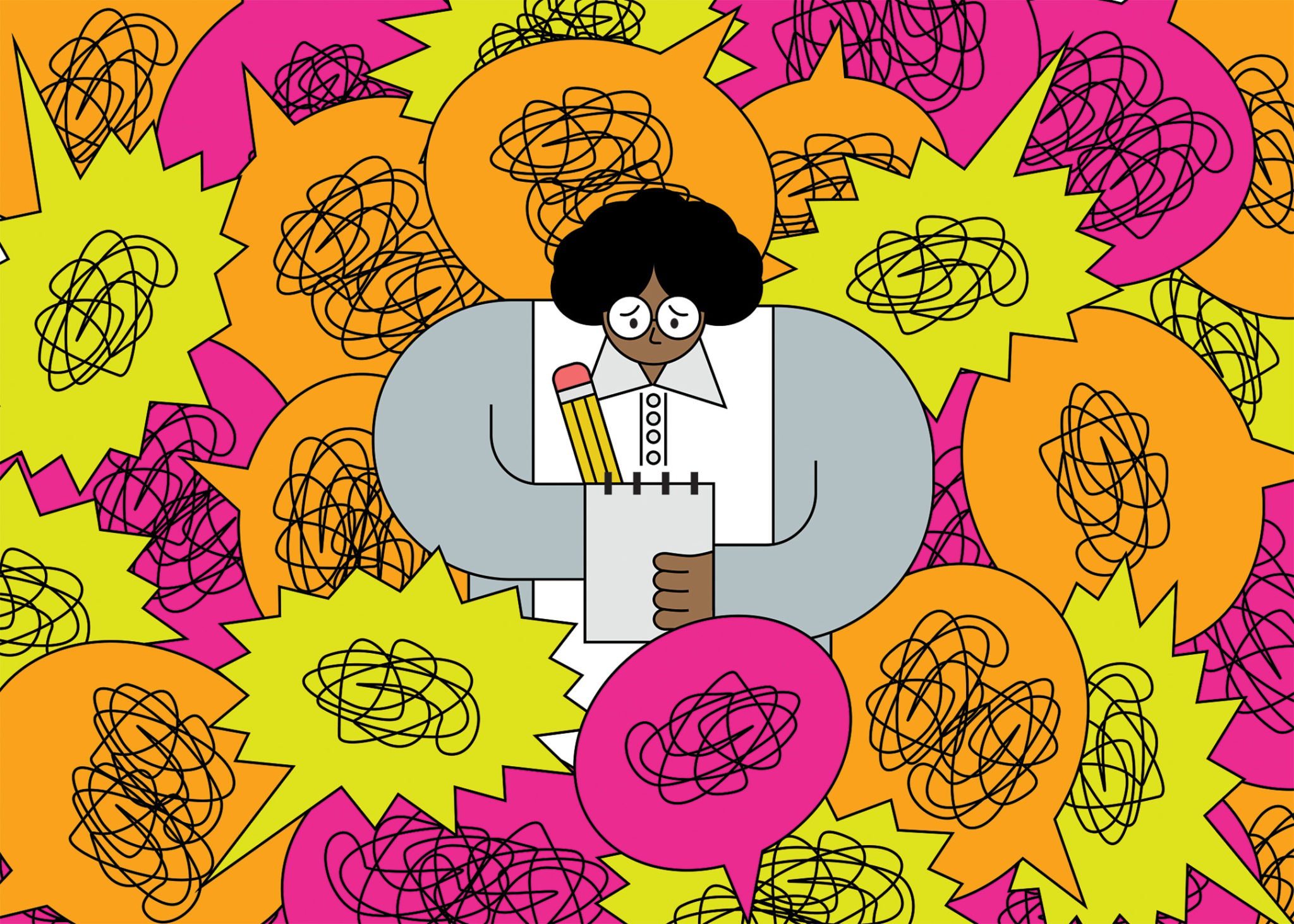Karen Osterle is a therapist who specializes in anxiety, anxious depression, and relationship issues. So for her, the pandemic has been like running one long Ironman Triathlon. Multiple times.
Osterle, who owns her own practice in Dupont Circle, saw a spike in patient inquiries during Covid’s early months—the calls and emails were endless, she says, and her waitlist was the longest it had been since her practice opened 16 years ago. As a therapist, of course, she was naturally inclined to help people, so she took on a handful of new clients.
While Osterle made sure not to overcommit herself, she still felt more drained and less present during sessions, and her marriage became strained, too, as she spent less time being present with her spouse.
Mental-health professionals have had to make space for clients’ pandemic-related fears while dealing with their own.
So the master became the student: Osterle increased her own practice of the methods she recommends to overworked and anxious clients. She has focused on exercise and wellness—upping the number of times a week she runs three and a half miles, making a point to meditate each morning before she starts sessions, and ending the workday with a half-hour stretch. She stopped working in the evenings—no more meeting clients at 7:30 pm. “In some ways, you gain time because you don’t have a commute,” says Osterle. “In other ways, time is melting into itself. Boundaries become more important than ever.”
She has seen similar burnout among her peers—hitting a wall due to increased workloads, greater demands for mental health, and the pandemic’s overall draining effect. “If the majority of therapists were being honest,” Osterle says, “I think it would be disingenuous if we said, ‘No, we’re fine. No problems.’ ”
A Mental-Health Crisis
About one of every five American adults struggles with mental illness, according to the National Institute of Mental Health, with about 52 million affected in 2020. The US already had barriers to those seeking mental-health care—especially people of color—such as affordability and an inadequate number of providers, and the pandemic has exacerbated this. In a 2021 American Psychological Association survey, 43 percent of participating psychologists saw increased demand across the board, with the greatest need being treatment for anxiety, depression, trauma, and stress. In the same report, 68 percent said their waitlist had expanded since Covid’s start, 41 percent reported not having the capacity to meet the heightened need, and 46 percent were experiencing burnout.
Therapist Monica Band, who owns a Capitol Hill practice, says the demand that started in the early days of the pandemic is still there, and her practice has been “swamped.” She has posted notices that her group is at capacity and isn’t accepting new clients, but she still receives up to 30 new-patient inquiries a day.
It’s not just Band’s actual workload that contributes to burnout. Like many of us, she feels drained after hours of staring at her computer during virtual sessions. What’s more, she says, “I feel very helpless knowing that I’m going to open up my email, I’m going to see at least 20 to 30 people who need help, and I’m going to try to do my best to refer them to people based on their preferences, but then those clinicians are also booked and there’s no one that can help them. And that’s not okay.”
Facing the Unknown
Drug overdoses and substance abuse have increased in the US during the pandemic, a trend that directly impacts therapists such as Aimee Chase, who works at a residential substance-abuse facility in Arlington.
Typically, Chase’s caseload would be eight to ten patients; during Covid, it shot up to 12 to 15, and she estimates that the facility’s waitlist doubled. Because counselors had to work in person throughout Covid, Chase says some felt unsafe and quit, contributing to a vicious cycle: The facility ended up understaffed, leading to even more people leaving because of burnout. (She recently had to take a medical leave, for unrelated reasons. Now there are five counselors at the facility—pre-pandemic, there were eight.)
For Chase, the workload led to anxiety, depression, and perpetual exhaustion. “You have a couple of weeks of feeling like you’re drowning, you’re not going to make it, wanting to quit, and then you kind of get used to it,” she says. “And you’re like, ‘Oh, okay, this is all right.’ And then it builds up again.”
Also hard: In normal times, a client might be dealing with anxiety and stress due to something that doesn’t affect the therapist, but in the last couple of years mental-health professionals have had to make space for clients’ pandemic-related fears while dealing with their own. “It can feel really helpless,” says Chase, “because it’s like, well, I don’t really know how to navigate this either.”
Dupont Circle therapist Jonathan Kirkendall is familiar with that struggle. Amid his increased workload—normally, he’d see 20 to 25 patients a week; at his pandemic peak, the number was 38—he says, like many of his clients, he felt unsure of the future: “There are no workshops that, as a therapist, I can take that are like, ‘Here are the three interventions you need to bring to your clients during a pandemic.’ ”
When one client described having to watch through a hospital window as her mother died, the story evoked memories for Kirkendall, who is gay, of not being able to say goodbye to loved ones during the AIDS epidemic. “I remember going in and sitting in the guest bedroom, which was my husband’s office,” he says about a moment after seeing clients, “and [telling him], ‘My head just doesn’t have room for all the stories.’ ”
Setting Boundaries
Sara Mindel, a therapist with her own practice in Dupont Circle who likewise has dealt with increased demand, notes that burnout is something therapists talk about from the beginning of their careers. But the current situation, she says, “is next-level.”
Like Osterle, Mindel began setting boundaries (a lesson for anyone who feels overwhelmed). Besides cutting down her client load, she now does something she hasn’t done in a decade: takes a lunch break.
“Burnout is not something you resolve by a vacation,” Mindel says. “It’s more: How do you shift your lifestyle so it can reflect your values and your needs?”
Other therapists have taken sabbaticals, or take breaks from returning calls or emails. Monica Band stays off her devices between sessions, tries to limit her news consumption, and routinely gives herself pep talks reminding herself that, even if it feels as though she’s not making noticeable progress with a client, she’s still effecting change in small and subtle ways.
As people settle into what seems to be a permanent relationship with Covid—against a backdrop of inflation, the war in Ukraine, mass shootings, and the overturning of Roe v. Wade—the mental-health crisis is unlikely to fade away anytime soon. This is especially true as people navigate a new normal after two-plus years at home, says Kirkendall. While his numbers have decreased a bit from the pandemic’s peak, he saw a recent spike in inquiries this spring when some companies instituted hybrid office policies. “It feels almost like people went back to work and were like, ‘Wait, what the f—? I can’t do this.’ ”
All of which is to say: It seems as if an emphasis on mental health is here to stay, so it’s important therapists make the space and time to care for themselves.
“I love what I do,” says Osterle. “It is such an honor and a privilege. And I love it most when I feel well and well-rested. [Then] I’m able to be really attuned and help people see some of what they might not see.”
This article appears in the September 2022 issue of Washingtonian.


















